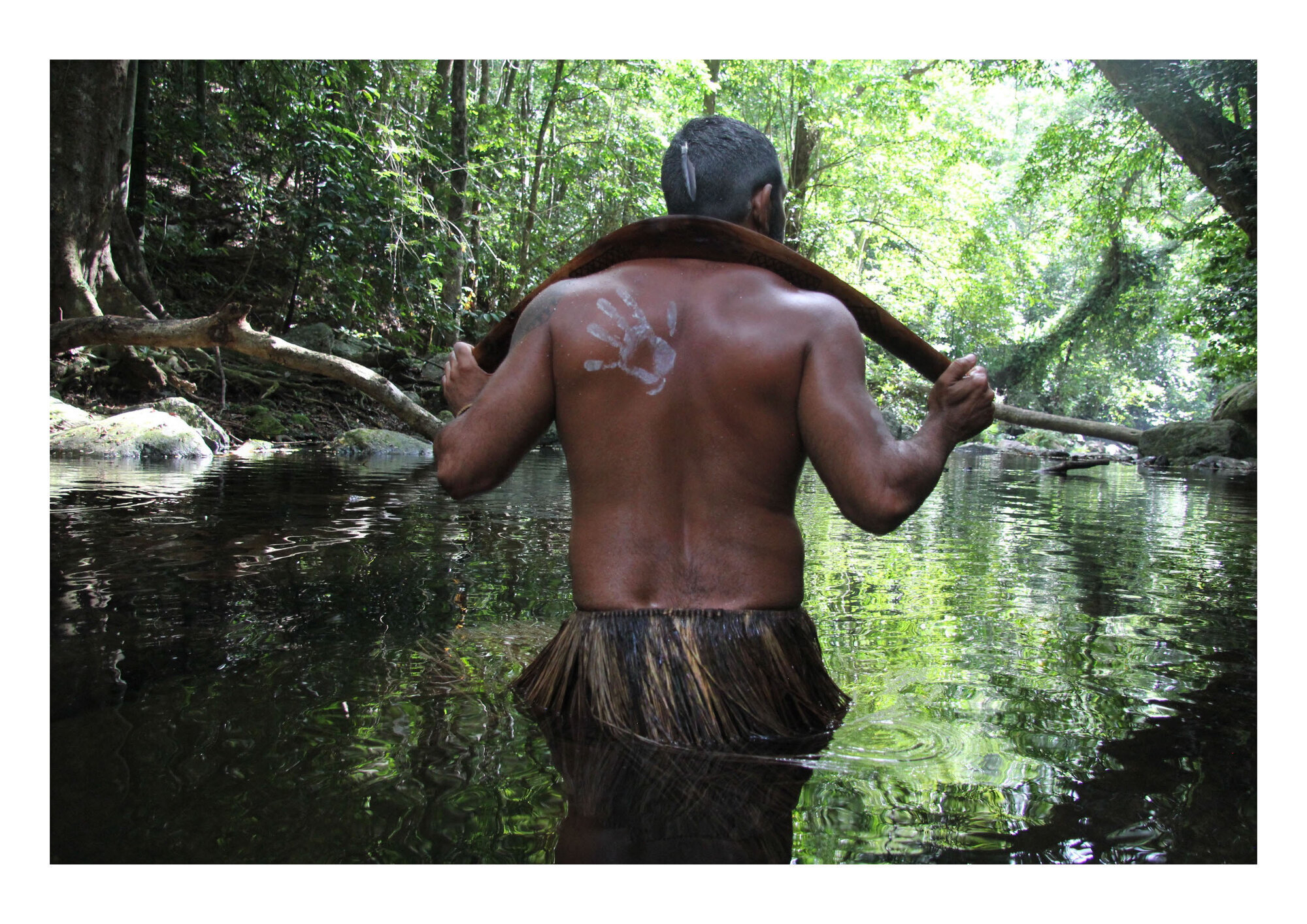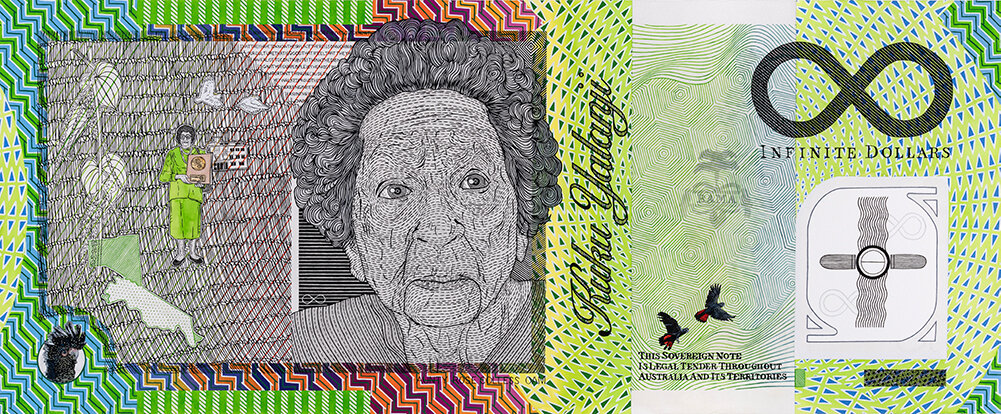Queen’s Land Blak Portraiture was a major Cairns Art Gallery exhibition based on research that explored relationships between personal, cultural and national identity in relation to historical and contemporary portrait images by Indigenous and non-Indigenous artists.
This exhibition forms part of the Cairns Art Gallery online First Nations Research Archive developed as part of the Gallery’s online Legacy Archive produced to celebrate the Gallery’s 30th anniversary.
Contemporary artists’ portraits in Queen’s Land Blak Portraiture explored how prevailing social, political, economic and cultural conditions, past and present, have shaped perceptions and representations of Indigenous Queenslanders. Works selected for the exhibition also reflected government policies that shaped public attitudes and the lives of Indigenous peoples in Queensland.
Historical portraits in the exhibition included archival photographs from early colonial times and from extensive mission settlement which had led to segregation, the control of Aboriginal peoples’ movements, and the removal of children from parents. The effects of these experiences are evident in the virtual lack of representation of Indigenous peoples in the mid-twentieth century, and it was not until 1967 that Indigenous Australians were counted in the Australian national census.
Contemporary artists represented in the exhibition included Vernon Ah Kee, Tony Albert, Michael Cook, Destiny Deacon, Fiona Foley, Heather Koowootha, Naomi Hobson, Danie Mellor, Dr Christian Thompson and Alick Tipoti.
The exhibition and supporting publication explored several narratives, such as identity and connection to country; the exotic and the ‘other’; types, stereotypes and profiling; narratives of dis/empowerment including segregation, protectionism, missions, family, education and assimilation; activism and human rights; and who we are now and how we want to be seen and heard. Narratives of youth were represented through Naomi Hobson’s Adolescent Wonderland series of photographs of young adults searching for individuality and identity in her home community of Coen.
While the cultures and histories of contact were very different, Aboriginal and Torres Strait Islander peoples drew the similar understanding that portraiture and identity does not conform to a Western art construct of a vertical image or representation of a person. Rather, a person’s image can be portrayed through a cultural totem, a body marking, a footprint or handprint, a particular place, person’s name, or a ritual.
The use of the word blak in the exhibition title paid homage to a 1990s construct, where removal of the letter ‘c’ from ‘black’ started as a play on words attributed to activist artist Destiny Deacon. The spelling came to be used to convey notions of empowerment and self-determination – concerns that informed works selected for the exhibition.

This project is presented in partnership with the Cairns Indigenous Art Fair. It has been assisted by the Australian Government’s Visions of Australia Program and is supported by The John Villiers Trust, and the Regional Arts Development Fund (RADF) that is a partnership between the Queensland Government and Cairns Regional Council to support local arts and culture in regional Queensland.
Explore
Artwork labels
Exhibition Catalogue
Exhibition Room Brochure
Virtual tour
Artist information
Visit Artist Showcase
Simone Arnol
Gertrude Davis
Heather Wunjarra Koowootha
Rosella Namok
Teho Ropeyarn
Kerry Trapnell
Alick Tipoti
Collection works
Tony Albert
Simone Arnol
Allira Charles
Michael Cook
Ray Crooke
Ezekiel Dick
Russell Drysdale
Gordon Hookey
Vernon Ah Kee
Heather Wunjarra Koowootha
Danie Mellor
Tracey Moffatt
Rosella Namok
Margaret Olley
Segar Passi
Ryan Presley
Teho Ropeyarn
Ellarose Savage
Kerry Trapnell
Alick Tipoti
Judy Watson
Shop
Ray Crooke
Vernon Ah Kee
Heather Wunjarra Koowootha
Rosella Namok
Segar Passi
Selected Works
 Tracey MOFFATT, I made a camera 2003, lithograph, Cairns Art Gallery. Gift of the artist, 2019
Tracey MOFFATT, I made a camera 2003, lithograph, Cairns Art Gallery. Gift of the artist, 2019
 Allira Charles , Ethel Thomas 2018, digital print, Cairns Art Gallery. Purchased 2018
Allira Charles , Ethel Thomas 2018, digital print, Cairns Art Gallery. Purchased 2018
 Simone ARNOL, Story water from the Through my eyes series 2016, digital print, Courtesy of the artist
Simone ARNOL, Story water from the Through my eyes series 2016, digital print, Courtesy of the artist
 Segar PASSI, Feast 2013, synthetic polymer paint on canvas, Cairns Art Gallery. Purchased with the assistance of the Cairns Regional Gallery Foundation, 2014
Segar PASSI, Feast 2013, synthetic polymer paint on canvas, Cairns Art Gallery. Purchased with the assistance of the Cairns Regional Gallery Foundation, 2014
 Vernon ah Kee, Merv Ah Kee (my father) 2017, charcoal, pastel, acrylic on linen, Cairns Art Gallery. Purchased 2017, Commissioned by Cairns Art Gallery
Vernon ah Kee, Merv Ah Kee (my father) 2017, charcoal, pastel, acrylic on linen, Cairns Art Gallery. Purchased 2017, Commissioned by Cairns Art Gallery
 Ryan PRESLEY, Blood Money -Infinite Dollar Note - Aunty Rose Colless OAM Commemorative 2019, watercolour, Cairns Art Gallery. Purchased 2019, Commissioned by Cairns Art Gallery
Ryan PRESLEY, Blood Money -Infinite Dollar Note - Aunty Rose Colless OAM Commemorative 2019, watercolour, Cairns Art Gallery. Purchased 2019, Commissioned by Cairns Art Gallery
 Heather Kunjarra KOOWOOTHA, Mother and Daughter's reunion 2013, etching, Cairns Gallery. Purchased 2014
Heather Kunjarra KOOWOOTHA, Mother and Daughter's reunion 2013, etching, Cairns Gallery. Purchased 2014
Installation Images
 Queen’s Land Blak Portraiture install, Cairns Art Gallery 2019.
Queen’s Land Blak Portraiture install, Cairns Art Gallery 2019.
 Queen’s Land Blak Portraiture install, Cairns Art Gallery 2019.
Queen’s Land Blak Portraiture install, Cairns Art Gallery 2019.
 Queen’s Land Blak Portraiture install, Cairns Art Gallery 2019.
Queen’s Land Blak Portraiture install, Cairns Art Gallery 2019.
 Queen’s Land Blak Portraiture install, Cairns Art Gallery 2019.
Queen’s Land Blak Portraiture install, Cairns Art Gallery 2019.
The Cairns Art Gallery acknowledges the Traditional Owners of the land on which we work and live. We pay our respects to Elders past and present. Aboriginal and Torres Strait Islander people should be aware that this website may contain images, names or voices of deceased persons in photographs, film or text.